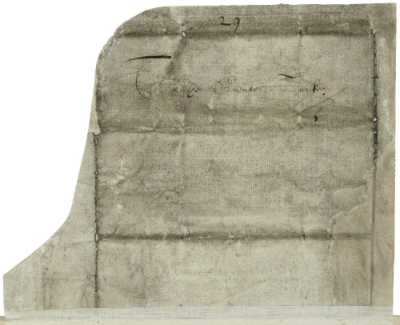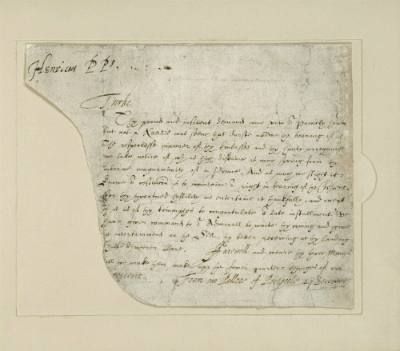Letter from Henry, Prince of Purpoole, to the Great Turk (Folger MS V.a.190)
Historical Records
Folger Shakespeare Library MS fragment
Two small leaves exist as Folger MS. V.a.190:

|

|
| Folger V.a.190, cover: "29. To ye Greate Turke" (CC BY-SA 4.0 licence; click image to view in full) |
Folger V.a.190, letter (CC BY-SA 4.0 licence; click image to view in full) |
The Letter from Henry, prince of Purpoole, to the Great Turk contains two leaves, one marked with the addressee ("To ye Greate Turke"), the other bearing the contents of the letter itself. The letter reads:
Henricus PPs
Turke
Thy proud and insolent demand came vnto our Princly hands but not a Nuntio was seene that durste avowe the bearing of it. The respeclesse manner of thy Embassee and thy hauty arrogance we take notice of with as high disdaine as may spring from the inborne magnanimity of a Prince, And as much we slight it: Knowe our resolucion is to maintaine our right in bearing of the Crescent. ffor thy threatned hostility we entertaine it thankfully, and accept of it as of thy triumphes to congratulate our Late installment. We have given command to our Admirall to waite thy coming and give the entertainment on the Sea, thy better receiving at thy landing shalbe our neerer Care. ffarewell and weare thy three Moones till we make them make upp the fower quarter = Changes of our [C]rescent.
From our Pallace of Portpoole. 27. December
Theatrical Provenance
The Folger catalogue entry (following Axton 85) notes that "[a] Henry Helmes was prince of Purpoole in the 1594 Christmas revels" and suggests that this fragment was "[p]robably part of the entertainment provided in the Gesta Grayorum, 1594-1595." If so, it would have been performed by the Gentlemen of Gray's Inn.
Probable Genre(s)
Royal Entertainment / masque (if part of the Gesta Grayorum).
Possible Narrative and Dramatic Sources or Analogues
Gesta Grayorum, or, The history of the high and mighty prince, Henry Prince of Purpoole ... who reigned and died, A.D. 1594 : together with a masque, as it was presented (by His Highness's command) for the entertainment of Q. Elizabeth, who, with the nobels of both courts, was present thereat. (London: Printed for W. Canning, 1688).
References to the Play
No references to this "letter" known.
Critical Commentary
The Folger's Hamnet catalogue entry notes that this fragment is "Not included in Gesta Grayorum, 1688, nor in J. Nichols’ Progresses of Queen Elizabeth, nor in Gesta Grayorum, edit. by Desmond Bland, 1968."
Chambers (1.168) describes the Gesta Grayorum as a "very magnificent Shrovetide mask" that "was brought to Court by the men of Gray's Inn, as a wind-up to their notable Christmas revels under the Prince of Purpoole." He observes that the "songs and speeches ... can be assigned respectively to Thomas Campion and Francis Davison." He explains that the Gesta Grayorum "is a narrative of the reign of a Christmas Prince, or Lord of Misrule ... appointed at Gray's Inn for the Christmas of 1594. The Prince was a Norfolk man, Henry Helmes, and a list of the members of the Inn who held positions at his court is given in the tract. The revels began on St. Thomas's Eve, 20 Dec., continued until Twelfth Night, were resumed at Candlemas, and again at Shrovetide, when the Prince's reign terminated" (4.55-56).
Nelson and Elliott reproduce the letter in their Inns of Court volume for REED (435-36), noting:
The context of the letter is described in the Gesta, which does not, however, contain the text. The ‘Turk’ is imagined as an enemy not so much of Gray’s Inn as of the Inner Temple, then visiting in the person of an ambassador from ‘Frederick Templarius, their Emperor, who was then busied in his Wars against the Turk’ (p 395, ll.29–30). It seems likely that this very document was read aloud during the course of the Gray’s Inn Christmas Prince revels by Henry Helmes, Prince of Purpoole. (364)
The most extensive critical commentary on the letter comes from Tiffany Stern, whose "Scrolls" section of Documents of Performance provides the following context for the material object:
Though theatrical scrolls are for the most part, like other ephemera, no longer extant, the early modern period does contain one preserved property letter for a 'staged' occasion. The document is a pretend letter that formed part of the Gray's Inn and Inner Temple revels held between Christmas 1594-5 and Shrove Tuesday and known as Gesta Grayorum: an extended feast of misrule. ... The text of Gesta Grayorum --- or, rather, a series of texts making up moments of it --- was published in 1688, and includes exchanges between Henry of Purpoole and Emperor Frederick as well as a number of their 'ambassadors' from 'overseas'. There is, for instance, a letter from 'Theodore Evanwhich, the great and mighty Emperor of all Russia' delivered by an ambassador who came 'in Attire of Russia' to the Prince. But the surviving 'letter' from the Gesta Grayorum, not printed in the 1688 collection, is the remnant of another 'ambassadorial' visit that was obviously intended not to be so courteous. In it --- its answer is not preserved --- the Prince exchanges angry words with a 'Turke' over use of the Islamic crescent. The letter actually seems to prepare for a sea-battle, in which the waiting 'Acmirall' ('Admiral') will trounce the Turkish warlord: it is one side of an exchange leading up to a performed moment. It is, nevertheless, in form and content, an elegant and seemingly 'real' letter (186)
Stern proceeds to analyse the significance of this unique extant example of a stage-letter:
This letter is not only neatly written; it contains individual features that match those to be found in printed texts that contain scrolls in 'realistic' form. Specifically, the change of manuscript style for its salutation --- here, from secretary hand into italic --- directly reflects the different typeface so often used in the salutation in printed texts. Most importantly, however, having been carefully folded, the letter contains a direction written on its outside detailing to whom it is to be delivered ('To the Greate Turke'), and a direction on the inside detailing from whom it emanates, 'Henricus P P'. That the addressee is named on the front of the property letter may explain why that detail did not always make it into plays, for, with any 'real document, it is the outside only that needs to name the person to whom the text is to be given (a crucial piece of information for players). As that piece of information, however, belongs to the scroll as much as, or more than, to the playbook, it is information that the playwright does not necessarily have to provide or even decide. (187)
For What It's Worth
The Gesta Grayorum has often been ascribed to Francis Bacon, Francis Davison and others; it is not clear who may have authored the fragment comprising Folger MS V.a.190.
Works Cited
Site created and maintained by David McInnis, University of Melbourne; updated 17 April 2012.